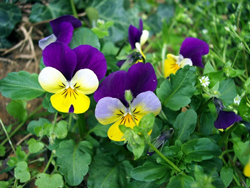![]()

Although Shakespeare wrote his plays about 400 years ago, in some ways the world he wrote about has hardly dated. For instance, the plants he referred to in his plays are the same ones we’re familiar with today.
In his Midsummer Night’s Dream, Oberon tells Puck to squeeze the juice of a flower onto the sleeping lovers as a love potion:
“Yet marked I where the bolt of Cupid fell:
It fell upon a little western flower,
Before milk-white, now purple with love’s wound,
And maidens call it love-in-idleness …
The juice of it on sleeping eyelids laid
Will make a man or woman madly doat
Upon the next live creature that it sees.”
 Shakespeare must have thought this flower was special.
Shakespeare must have thought this flower was special.
The flower he’s referring to is the pretty viola tricolor, known as heart’s-ease, which sounds more like an angina medication. Maybe the name came from its supposed potency in love charms.
It’s also known by the delightful names butterfly flower, wild pansy, kiss-me-quick, kiss behind the garden gate, love-in-idleness, three faces under one hood, and Johnny-jump-up.
The viola is a relative of the pansy. The name pansy comes from the French work penseé which means ‘thought’, probably because the pansy looks like it has a face. When a bouquet of pansies is given to you, it means, “I’m thinking of you.”
In Hamlet, Ophelia says:
“There’s rosemary, that’s for remembrance: pray you, love, remember.
And there is pansies, that’s for thoughts.”
 These pansies look like little men with moustaches.
These pansies look like little men with moustaches.
Shakespeare makes many references to plants, which I will write about again soon.
Happy Puzzling!
![]()


Recent Comments